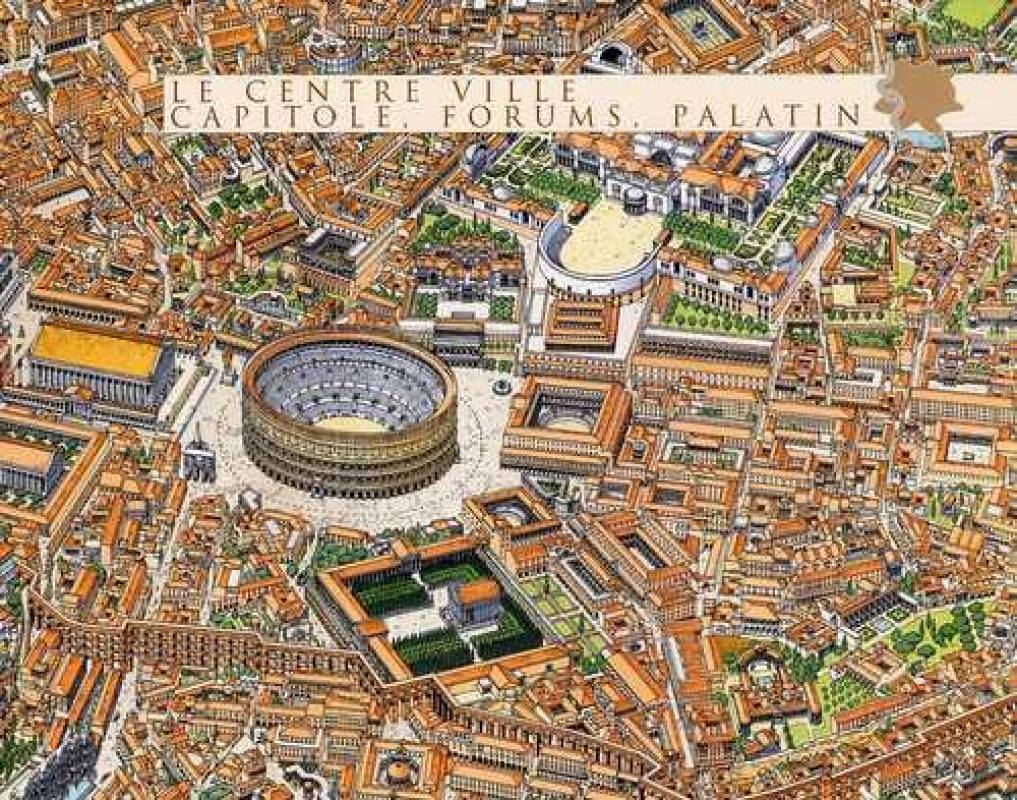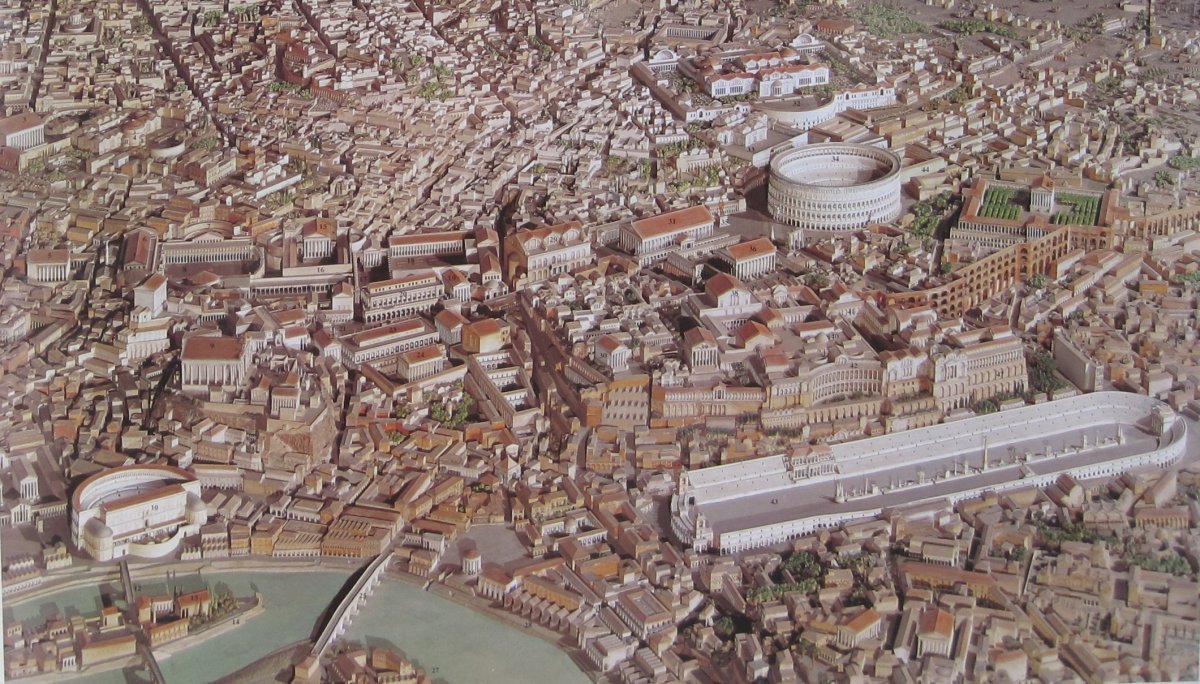"History in 3D"

Ancient Rome 320 AD
1st trailer
It is a promo of the large and high detailed 3D reconstruction of the center of ancient Rome. We are working with it for several years, and the final product will be released in a few months. It will be integrated in a game engine, so you all will be able to walk along these streets, forums and palaces!

Ancient Rome 320 AD
2nd trailer
Danila Loginov
Here is the 2nd trailer about our large project - detailed 3D reconstruction of the center of ancient Rome as it was in 320 AD. Some new buildings are added, these are most temples of Capitoline hill, temple of Divine Augustus, basilica Argentaria etc. The further improvements are in progress and you will be able to see them in a near future.
Here is the 2nd trailer about our large project - detailed 3D reconstruction of the center of ancient Rome as it was in 320 AD. Some new buildings are added, these are most temples of Capitoline hill, temple of Divine Augustus, basilica Argentaria etc. The further improvements are in progress and you will be able to see them in a near future.

Ancient Rome 320 AD
3rd trailer
3rd trailer
"Walking around Colosseum"
Touted as the most detailed 3D rendering of the ancient metropolis, Danila Loginov has presented his third and final promo of the ‘eternal city’ of Rome at its architectural peak, circa 320 AD (watch the first and second animated promo).
This time around, running over 10 minutes of awesomeness, the animation
video (part of the Rome in 3D project) features a range of ancient
landmarks such as the temple of Divine Augustus, Basilica Argentaria,
the baths of Trajan and Titus to the Colosseum (along with the statue of
Colossus Solis), arches of Titus and Constantine, and Ludus Magnus.
Danila Loginov
Published on Feb 11, 2018
Here is the 3rd video trailer, illustrating our project dedicated to reconstruction of the whole center of ancient Rome city as it was in 320 AD. Also this is the last trailer before the release of 3d walkthrough, where you will be able to enjoy this reconstruction by yourself using modern and innovative 3D technologies.
https://www.realmofhistory.com/2018/02/19/astounding-3d-animation-rome-320-ad
In Loginov’s own words –
We are happy to present a new, 3rd trailer of our project, which dedicated to ancient Rome 3D reconstruction, as it was in 320 AD. Previously we have shown the Forums area, and also Palatine and Capitolium hills with their palaces and major temples. Now, upon the user requests, we have focused on the other location of the center of ancient Rome – it’s now the area around Colosseum.This great amphitheater surely dominates all over around territory, in the meantime, there were a number of magnificent buildings which are also worth to be reconstructed. These are baths of Trajan and Titus, the statue of Colossus Solis, arches of Titus and Constantine, Ludus Magnus, the temple of Divine Claudius. Our team spent some time an recreated this area along with all minor buildings as a complex and added it to the model which has been already done. So we have now almost the entire center of ancient imperial Rome already recreated!
What is our “Rome in 3D” project in general? Broadly speaking, it is an attempt to give you an opportunity to take a look at Rome as it really was, by the eyes of humans who lived there in that time. Due to this, we are already paying much attention (and will proceed) to the level of details, adding realistic materials, colors, visual and weather effects. That’s why we are concentrating just on the center of the Rome for now, just to focus on quality and details.
Now we are planning to add a little additional territory (such as Circus Maximus, Velabrum area), and release our project as a 3d walkthrough application. I hope we will be able to complete it in a year approximately.
The significance of 320 AD –
Lastly, the question may naturally arise – why choose the year 320 AD? Well as we discussed earlier in one of our articles –
As for the significance of early 4th century in Rome’s (the city) history, the period mirrored wide-ranging political and religious upheavals in the capital. In many ways, this short epoch reflected the change from classical avenues to ‘Christianized’ scopes, especially with the rise of Constantine. And almost in an ironic manner, such changes brought about the last spurt of architectural achievements in ancient Rome itself – and these ‘church’ structures were complemented by the earlier incredible specimens built by the ‘pagan’ Romans. Simply put, most of what we know about ancient Rome in our modern age comes from this period, along with the glorious preceding years before the rise of Constantine.
Unfortunately, by 410 AD, Rome unceremoniously lost its status as the administrative center of the western Roman realm, while Constantinople (now Istanbul) had already overtaken the ‘eternal city’ in terms of growth and influence in the late 4th century. Interestingly, by virtue of its newfound status as the wealthiest city in Europe, Constantinople was also called Nova Roma (Νέα Ῥώμη or ‘New Rome’), thus attesting to the power and prestige of original Rome in its imperial heyday.
Thanks, Danila Loginov. Check out his YouTube channel for various other historical reconstructions.
Published on Feb 11, 2018
Here is the 3rd video trailer, illustrating our project dedicated to reconstruction of the whole center of ancient Rome city as it was in 320 AD. Also this is the last trailer before the release of 3d walkthrough, where you will be able to enjoy this reconstruction by yourself using modern and innovative 3D technologies.
https://www.realmofhistory.com/2018/02/19/astounding-3d-animation-rome-320-ad
In Loginov’s own words –
We are happy to present a new, 3rd trailer of our project, which dedicated to ancient Rome 3D reconstruction, as it was in 320 AD. Previously we have shown the Forums area, and also Palatine and Capitolium hills with their palaces and major temples. Now, upon the user requests, we have focused on the other location of the center of ancient Rome – it’s now the area around Colosseum.This great amphitheater surely dominates all over around territory, in the meantime, there were a number of magnificent buildings which are also worth to be reconstructed. These are baths of Trajan and Titus, the statue of Colossus Solis, arches of Titus and Constantine, Ludus Magnus, the temple of Divine Claudius. Our team spent some time an recreated this area along with all minor buildings as a complex and added it to the model which has been already done. So we have now almost the entire center of ancient imperial Rome already recreated!
What is our “Rome in 3D” project in general? Broadly speaking, it is an attempt to give you an opportunity to take a look at Rome as it really was, by the eyes of humans who lived there in that time. Due to this, we are already paying much attention (and will proceed) to the level of details, adding realistic materials, colors, visual and weather effects. That’s why we are concentrating just on the center of the Rome for now, just to focus on quality and details.
Now we are planning to add a little additional territory (such as Circus Maximus, Velabrum area), and release our project as a 3d walkthrough application. I hope we will be able to complete it in a year approximately.
The significance of 320 AD –
Lastly, the question may naturally arise – why choose the year 320 AD? Well as we discussed earlier in one of our articles –
As for the significance of early 4th century in Rome’s (the city) history, the period mirrored wide-ranging political and religious upheavals in the capital. In many ways, this short epoch reflected the change from classical avenues to ‘Christianized’ scopes, especially with the rise of Constantine. And almost in an ironic manner, such changes brought about the last spurt of architectural achievements in ancient Rome itself – and these ‘church’ structures were complemented by the earlier incredible specimens built by the ‘pagan’ Romans. Simply put, most of what we know about ancient Rome in our modern age comes from this period, along with the glorious preceding years before the rise of Constantine.
Unfortunately, by 410 AD, Rome unceremoniously lost its status as the administrative center of the western Roman realm, while Constantinople (now Istanbul) had already overtaken the ‘eternal city’ in terms of growth and influence in the late 4th century. Interestingly, by virtue of its newfound status as the wealthiest city in Europe, Constantinople was also called Nova Roma (Νέα Ῥώμη or ‘New Rome’), thus attesting to the power and prestige of original Rome in its imperial heyday.
Thanks, Danila Loginov. Check out his YouTube channel for various other historical reconstructions.


No comments:
Post a Comment